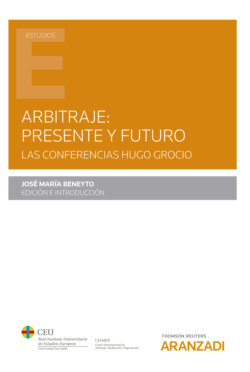Читать книгу Arbitraje: presente y futuro - José Mª Beneyto Pérez - Страница 3
На сайте Литреса книга снята с продажи.
Índice General
ОглавлениеINTRODUCTION
JOSÉ MARÍA BENEYTO
INTRODUCCIÓN
JOSÉ MARÍA BENEYTO
CAPÍTULO I
TOWARDS A NEW PARADIGM IN INTERNATIONAL ARBITRATION. THE TOWN ELDER MODEL REVISITED
DAVID W. RIVKIN
CAPÍTULO II
EL LAUDO: NATURALEZA, CLASES Y CONTENIDO
MANUEL OLIVENCIA RUIZ
I.Introducción
II.Clases de laudos
1.Laudo parcial
2.Laudos definitivos y laudos firmes
A)Definitivos
B)Firmes
3.Laudo por acuerdo de las partes
III.Contenido del laudo
1.Régimen de la regulación
2.Motivación
3.Fecha y lugar
4.Costas
5.Firmas
6.Pareceres discrepantes
7.Requisitos no exigidos por la LA
CAPÍTULO III
LA PARTICIPACIÓN DE LOS ESTADOS EN EL ARBITRAJE INTERNACIONAL
BERNARDO CREMADES
I.Introducción
II.La protección de la soberanía en el plano internacional
III.El abandono de la doctrina Calvo
IV.Hacia un Derecho administrativo globalizado
V.El arbitraje internacional como consecuencia y, a la vez, como catalizador de la internacionalización de los contratos administrativos
VI.Los Estados en el arbitraje comercial internacional
VII.Los Estados en el arbitraje de protección de inversiones
VIII.¿Puede decirse que vuelve la doctrina Calvo?
IX.Países en desarrollo y arbitraje internacional
CAPÍTULO IV
CROSSING THE MARE LIBERUM: THE SETTLEMENT OF DISPUTES IN AN INTERCONNECTED WORLD
CHRISTIAAN KRÖNER
I
II
III
CAPÍTULO V
EVIDENCE, ARGUMENT, DR. JOHNSON AND GROTIUS
JOHN BEECHEY
CAPÍTULO VI
NAVIGATING INTERNATIONAL DISPUTE RESOLUTION: INNOVATIONS IN INVESTOR-STATE ARBITRATION
MEG KINNEAR
Introduction
International economic law roots of investment arbitration
Innovation of individual claims and investor-state dispute settlement
Capacity to adapt and innovate
Some recent innovations – access to documents, access to hearings, third party submissions, and dismissal for lack of legal merit
Access to documents
Open hearings
Third party participation
ICSID rule 41(5)
Jurisprudence constante
ICSID practice innovations
Ideas for future
Conclusion
CAPÍTULO VII
LA LUCHA CONTRA LA CORRUPCIÓN DESDE EL ARBITRAJE
JUAN FERNÁNDEZ-ARMESTO
1.Introducción
2.Contratos que encubren pagos corruptos
Competencia
Los efectos civiles
Prueba
Deber de investigar
3.Contratos obtenidos por medio de pagos corruptos
World Duty Free c. Kenia
Efectos civiles
Anulabilidad
Convalidación
4.Arbitraje de inversión
Metal-Tech c. Uzbekistán
5.La venganza contra el incorruptible
EDF c. Rumanía
6.Conclusión
7.Referencia bibliográfica
CAPÍTULO VIII
ARE FEAR, DISINFORMATION, POLITICS AND THE EUROPEAN COMMISSION BECOMING THE FOUR HORSEMEN OF THE APOCALYPSE FOR INTERNATIONAL INVESTMENT DISPUTE ARBITRATION?
JUDGE CHARLES N. BROWER
Introduction
Investment Treaties and Arbitration are Not Harmful or Ineffective
Arbitration Is Not One-Sided
Proceedings Are Not “Secretive”
Arbitration Does Not Threaten Sovereignty or Result in “Regulatory Chill”
Background
Recent Developments
An Alternative to ISDS?
Substantive Protections
Avoiding the “Bunker” Mentality
Glimmers of Hope
Conclusion
CAPÍTULO IX
TRANSNATIONAL PUBLIC POLICY: ITS APPLICATION AND EFFECT BY INTERNATIONAL ARBITRATION TRIBUNALS
JULIAN D. M. LEW
I.Introduction
II.Applicable Rules in International Arbitration
A.Party Autonomy
B.Arbitrators’ Selection
C.Overriding Rules
III.Overriding Rules in International Arbitration
A.Mandatory Rules
B.Transnational or Truly International Public Policy
1.Demystifying the Notion of Public Policy
2.The Development of Transnational Public Policy: Sources and Content
(i)The Prohibition Against Corrupt Activities
(ii)Illicit Trafficking
(iii)Terrorism
IV.APPLICATION BY INTERNATIONAL ARBITRAL TRIBUNALS
V.CONCLUSION
CAPÍTULO X
LA SOFT LAW COMO CONDICIÓN PARA EL DESARROLLO DE LA CONFIANZA EN EL ARBITRAJE INTERNACIONAL
ALEXIS MOURRE
CAPÍTULO XI
INSTITUTIONAL ARBITRATION: HARMONY, DISHARMONY AND THE “PARTY AUTONOMY PARADOX”
KLAUS PETER BERGER
1.Introduction
2.What is “Institutional” Arbitration?
3.Institutional Arbitration and Party Autonomy
3.1.The Parties’ Stand-Alone Choice of an Arbitral Institution or its Rules
3.2.The Parties’ “Disharmonious” Choice of Arbitral Institution and Arbitration Rules
3.3.The Parties’ Deviation from “Mandatory” Provisions in the Arbitration Rules
3.4.Party Autonomy and Institutional Discretion: The “Party Autonomy Paradox”
4.Conclusion
CAPÍTULO XII
ISDS AND FREEDOM OF INFORMATION: WHAT ROLE FOR PUBLIC SCRUTINY IN THE RESOLUTION OF INTERNATIONAL DISPUTES?
HUGO HANS SIBLESZ
LISTADO DE LAS “CONFERENCIAS HUGO GROCIO” (2007– 2019). CIAMEN – REAL ACADEMIA DE JURISPRUDENCIA Y LEGISLACIÓN
